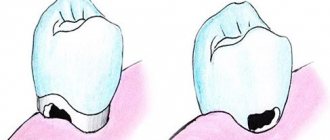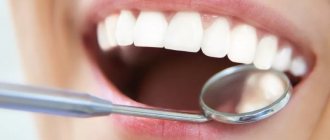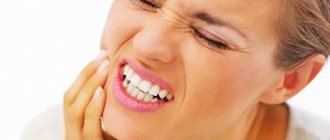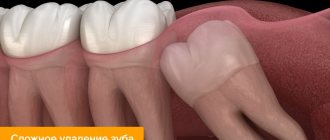Why do you need to brush your teeth?
Oral hygiene is not only a matter of aesthetics. It is due to medical reasons. A plaque constantly forms on the enamel, consisting of: • food particles; • saliva; • waste products of microorganisms inhabiting the oral cavity.
The process of plaque deposition does not depend on whether a person ate in the interval between brushings. If it is not removed, over time it turns to stone. Contamination not only creates a cosmetic defect. Deposits contribute to the violation of the integrity of the enamel. Pathogenic bacteria penetrate into the resulting cracks and actively multiply under conditions of poor hygiene. This is how caries begins with all the known consequences. These microorganisms also attack the gums. In people who neglect to brush their teeth, gingivitis becomes chronic. If the inflammation is not treated, complications in the form of periodontitis and periodontal disease are possible. As a result, the root no longer holds in the socket and the tooth falls out.
Why milk and dairy products are good for teeth
First of all, the positive effect is due to the high content of calcium in them - the main building material of bone tissue. The presence of the milk carbohydrate lactose improves its absorption [1]. In addition, the composition contains substances with an antimicrobial effect. Thus, milk and dairy products:
- promote remineralization of tooth enamel [1];
- suppress harmful microflora of the oral cavity [1];
- create a protective film on the surface of the enamel [2];
- increase the resistance of enamel to acids, thereby reducing the risk of caries [3].
How to brush your teeth correctly?
It is a mistaken idea that everyone can do this. There are a number of rules, many of which are either unknown or ignored. However, only compliance with them guarantees effective cleaning of the enamel: • Carrying out hygiene procedures not only at home, but also at the dentist. • Rational selection of brushes and paste. • Using the optimal teeth brushing method. • Using dental floss, brushes and mouthwash. • Taking into account the condition of the gums, the presence of braces and dentures. • Compliance with the rules for storing, cleaning and replacing brushes.
Tablets for determining plaque will help you understand whether you have achieved your goal. They demonstrate whether unwanted deposits are present on the enamel. They also suggest which areas are not being worked through carefully enough.
Choosing a toothbrush
To completely clean the enamel from plaque, you need to choose a suitable brush. The easiest way to do this is by material. There are two options here - natural and synthetic. It is better to give preference to the latter, since they are quite elastic, and the tips of the hairs are usually rounded, which is safer for the gums. Bacteria multiply faster on natural materials.
In terms of the stiffness of the bristles, toothbrushes are: • Soft. They are best taken for children, adolescents and people suffering from gingivitis. • Average. A universal option for people without dental problems. • Tough. They help fight hard plaque and can be used only when indicated.
The configuration of the bristles should be discussed with your dentist. It will tell you where more sediment collects. For example, if you need to better work on the necks of teeth, bristles collected in bunches can handle this.
Diet for lactase deficiency
What rules should you follow to prevent diarrhea after milk?
You should limit your consumption of dairy products. In addition, you need to remember that lactose is also contained in other products. It is present in baked goods, omelettes, semi-finished products, and confectionery products.
Nutrition rules:
- combine milk with cereal products;
- consume dairy products in small quantities;
- replace with lactose-free analogues.
The fat content of milk does not affect the amount of lactose. Therefore, if you reduce fat content, it will not save you from diarrhea.
Lactose content in products, per 100 g:
| product | quantity |
| powdered milk | 51.5 g |
| condensed milk 10% | 12.5 g |
| condensed milk with sugar | 10.2 g |
| milk 3.5% | 4.8 g |
| ice cream | 1.9-7.0 g |
| milk yogurt | 4 g |
| creamy yogurt | 3.7 g |
| kefir | 6.0 g |
| cottage cheese | 2.6 g |
| sour cream 10% | 2.5 g |
| milk chocolate | 9.5 g |
| curdled milk | 4.1 g |
| nougat | 25 g |
| milkshake | 5.4 g |
If you have problems with lactase deficiency, you should pay attention to the composition of the products and the lactose content in them.
Pasta selection
Pastes are hygienic, preventive and therapeutic. The first ones solve the only problem - clean the enamel. The latter, due to the antiseptic component, help prevent the development of gingivitis and caries. Still others are prescribed by dentists for therapeutic purposes; it is better not to use them on your own.
Toothpastes are also distinguished according to the results of use: • whitening - slightly lighten the enamel, but you should not expect drastic changes from them; • strengthening – contain fluoride, good for enamel health; • desensitizing - reduce sensitivity; • anti-inflammatory - help with gingivitis.
Abrasiveness characterizes the degree of impact on plaque. The average value of this indicator is from 50 to 80. Higher values can be taken occasionally to lighten teeth. Lower abrasiveness is indicated for sensitive enamel and gums.
Proper brushing of teeth: sequence of movements
For hygiene purposes, you need to accustom yourself to a certain sequence of movements.
After squeezing the paste onto the brush, you must: • apply it to the teeth at an angle of 45 or 90 degrees; • pass each one 3-4 times in the direction from the gums to the cutting edge; • treat chewing surfaces with circular movements; • Allow at least 30 seconds of brushing for each half of the jaw. Depending on the location of the brush and the direction of movement, there are three methods of brushing teeth. The most famous (90 degree brush, top to bottom movements) is the Leonard method.
The Bass method involves choosing an angle of 45 degrees and making vibrating movements. It is good because the bristles penetrate into the interdental spaces and partially work out the contact surfaces. With the Fones method, an angle of 90 degrees is taken and the brush moves in a circle. This further massages the gums, which improves blood circulation and protects against inflammatory processes.
Additional oral cleansing
Oral hygiene is not limited to two rows of teeth. For complete cleansing it is necessary to treat: • Interdental spaces. Dental floss or a brush will help remove plaque. • Language. To do this, use the relief surface of the back of the toothbrush or a special scraper. • Gums. They are partly cleaned with a brush: at an angle of 45 degrees, the bristles approach the edge and capture deposits. Rinse aid also helps. • Cheeks. You can go over them with the back of the brush, but they require more rinsing.
You need to start by removing the largest food debris. To do this, just rinse your mouth with water. Then comes the turn of fragments stuck in the interdental spaces - this is where floss comes to the rescue. Now you can take up the brush with the paste. Rinse aid is used last - to create a protective layer.
How to replace milk if you are lactose intolerant
Limiting the consumption of dairy products can lead to calcium deficiency. This is dangerous due to the deterioration of bone tissue. There is a risk of developing osteoporosis and pathological fractures.
It is necessary to increase your calcium intake by eating other foods.
We recommend watching the video:
It is recommended to use the following products in your diet:
- white cabbage, broccoli;
- salads
- spinach;
- turnip;
- eggs;
- chocolate milk.
Recently, lactose-free milk can be found on store shelves.
Cheeses supply the body with calcium. It is necessary to pay attention to varieties that contain little lactose, for example, mozzarella, cheddar and others.
Most people who are lactose intolerant can handle small amounts of dairy products. It is recommended to use them little by little.
How to brush your teeth with gingivitis?
Inflammation of soft tissues is not a reason to neglect hygiene. On the contrary, the more often cleansing is done, the less chance bacteria have to support the inflammatory process.
However, you need to take precautions: • choose brushes with soft bristles (preferably rounded); • choose a paste with low abrasiveness and containing medicinal herbs; • give preference to the Bass method, and abstain from the Fones method until remission; • move your hand more carefully to avoid painful sensations.
Cleaning time should not be shortened, even if the procedure causes discomfort. Sometimes dentists even recommend increasing it. Inflammation of the gums is accompanied by the formation of pockets. Where their edges lag behind, stone grows with particular intensity. This place deserves more careful study.
Is it possible to cure pathology?
What to do if the diagnosis of lactase deficiency is confirmed by a doctor? How to treat, what to do so that the unpleasant sensations do not recur?
For lactase deficiency, elimination diet therapy is prescribed. In other words, it is necessary to limit the consumption of products containing lactose.
With alactasia, when the body is unable to process foods containing lactose, a special diet is prescribed for life. It is necessary to exclude products with lactose.
Preparations are produced that supply the necessary enzymes.
The pharmaceutical industry produces the following drugs:
- medicines with the necessary enzyme, for example, Laktrazar, they are taken simultaneously with products containing lactose;
- preparations with lactose, for example, Lactaid, they are added to milk.
Using these drugs, you can consume foods containing lactose without unpleasant consequences.
How to clean dental structures?
Dental structures in the mouth make adjustments to the cleaning process: • Crowns. More attention should be paid to the area where the gums come into contact with the prosthesis. • Bridges. A round mono-tuft brush is more suitable for them. • Veneers. The teeth where they are installed cannot be treated with floss. The ban does not apply to other methods. • Braces. The space under the arch and the area adjacent to the enamel is cleaned with brushes.
In all of the above cases, it is necessary to use an irrigator. Conventional cleaning devices are not able to penetrate all the places where plaque accumulates. There are no barriers for water. Under the pressure set by the device, it knocks out stuck food fragments, preventing them from decomposing or turning into stone.
How do plaque tablets work?
We usually contact a dentist to assess the quality of oral hygiene. It identifies areas that are not cleaned effectively and makes recommendations for replacing the paste or brush. But in between visits to the clinic, you can cope without the help of a doctor.
Special tablets, developed by the Swiss company CURADEN, will help with this. They are part of the CURAPROX range of dental care products. Determination of plaque occurs as follows: • the tablet is diluted in water; • after brushing, a person rinses his mouth with this solution, distributing it over his teeth; • deposits are stained, clean enamel remains intact.
The tablets also help distinguish soft plaque from tartar. The first one becomes pink, the second one becomes dark blue. This way you can understand whether it’s time to go for ultrasonic cleaning.
How to clean with milk correctly
To achieve results, at least half an hour must pass after eating. It is better to use a soft or medium-hard brush so as not to injure the gums and the inner surface of the cheeks. Do not press hard, act carefully, avoid sudden movements.
The procedure can be performed 2-3 times a week:
- Pour some milk into a clean, dry jar with a tight-fitting lid.
- Rinse your mouth with warm water to remove food particles and moisten the surface.
- Wet the bristles of a toothbrush and dip them in milk powder.
- Brush your teeth for 2-4 minutes.
- Rinse several times with water.
Small particles of powdered milk really whitened my teeth, the inflammation of the gums that tormented me decreased, caries and tartar bother me less.
A cheap simple cleaning takes less than 5 minutes, and the result is not inferior to expensive dental procedures.
What's in a Nature's Medicine Cabinet: Common Foods, Herbs and Spices for Antibiotics, Painkillers and Digestive Aids
Reasons why it is better to drink chicory instead of coffee.
How does an elliptical trainer differ from a treadmill and an exercise bike, and why should you buy one for your home?
Source: aktsport.ru
Consequences of not brushing your teeth properly
Proper and timely cleaning of dental plaque is protection against oral diseases.
If you neglect it, the consequences will only increase: • Tartar forms. It gives off an unpleasant odor. If you do not carry out ultrasonic cleaning, it will become a favorite place for bacteria. • Bacteria will destroy the enamel. The abundance of pathogenic microorganisms quickly leads to caries. • Bacteria will cause your gums to become inflamed. Soft tissues are no less sensitive to them than hard ones. And this means bleeding, swelling and an unpleasant odor.
Possible complications are also worth mentioning. Caries develops into pulpitis, which requires removal of the nerve. This deprives the tooth of nutrition, as a result of which it sooner or later collapses. Progressive gingivitis is fraught with periodontitis and periodontal disease. Lack of oral hygiene leads to tooth loss. Restoring them is more expensive than the cost of a brush, paste and professional cleaning. Therefore, it is better to remember these simple rules and follow them.
What you don't know about toothpastes
Regardless of the price and manufacturer, any toothpaste contains aggressive chemical compounds, metal salts, and antibiotics. Over the years, harmful substances slowly but steadily accumulate in the body, causing a number of problems:
- disrupt the functioning of the digestive system;
- provoke allergies;
- thinning tooth enamel;
- irritate the gums, dry out the oral mucosa;
- load the kidneys and liver;
- destroy bone tissue;
- impair memory;
- lead to dysbacteriosis;
- slow down metabolism;
- suppress the immune system;
- reduce vision.
In 30-40 seconds, part of the composition is absorbed through the mucous membrane. Toxic components enter the blood and spread throughout the body. It turns out that every day, morning and evening, we slowly poison ourselves.
Toothpaste can cause significant harm to a pregnant woman: lead to changes in hormonal levels, affect the formation of the fetus.
Children are at risk - the effects of some pastes can affect growth and development.










